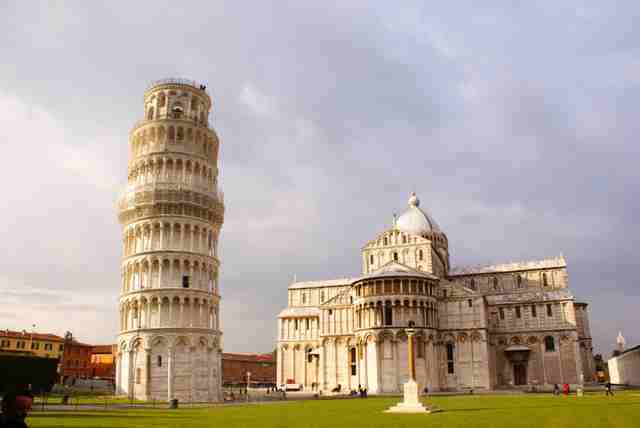
The Leaning Tower of Pisa is also called Torre pendente di Pisa in Italian or simply Torre di Pisa (Tower of Pisa) and it is the freestanding bell tower or campanile, of Pisa’s cathedral. This landmark is very well-known because of its unintended tilt form. If you want to know where is the Leaning Tower of Pisa located, it is at the rear side of the Cathedral and it is the Cathedral Square’s third oldest building (next to the Cathedral itself and the Baptistery).
One of the most commonly known Leaning Tower of Pisa facts is that its tilt started during its construction. The ground it was built upon was too pliable on one side and thus there was inadequate foundation to support the weight of the structure.
The ground was soft subsoil and it had difficulty in supporting the 14,500 ton weight of the tower. The tilt became more noticeable and got worsened when a second story was added. The tilt continued to increased before the completion of the project until it eventually stabilized and corrected partially through efforts done in the late 20th century to the early 21st century.
Leaning Tower of Pisa Facts for Kids
The following are some fun facts that children could enjoy learning.
- The Tower of Pisa is leaning because it was built on a soft ground
- It was built to be a bell tower
- Originally the tower leaned at an angle of 5.5 degrees. After restoration work between 1990 and 2001 this angle was reduced to 3.97 degrees.
- The tower is eight stories high, 183.27 feet on its low side and 185.93 feet on its high side.
- The construction of the tower begun in 1173 and it was completed by 1372. It took a while to complete because the construction was stopped and then restarted two times over those almost 200 years because of the wars.
- If it wasn’t for the war that stopped the construction for a century, the tower would definitely have toppled over. The soil settled and solidified thus, the tower only leaned to one side
- In 1987, the whole Cathedral Square – including the tower – became a UNESCO World Heritage Site.
- The south side of the tower has 296 steps while the north side has 294 steps.
- There are seven bells in the bell-chamber and the bells represent the seven notes of the musical major scale.
- The design of the tower was widely attributed to Bonanno and Guglielmo Pisano, but recent studies imply that architect Diotisalvi was also involved in the design.
- Other names that came up when the design was discussed include, Gerardo di Gerardo (phase 1), and Giovanni di Simone (phase 2).
- It was Tommaso di Andrea Pisano who oversaw the tower’s completion.
- The tower was saved from being bombed by the Allied forces during WWII despite the fact that the Germans used it as a lookout, simply because it was too beautiful and impressive to destroy.
Leaning Tower of Pisa History
The leaning Tower of Pisa was built in 1173 but it wasn’t after 199 years before it was completed. The issues the led to the constant discontinuation of the construction include the wars, debt and the engineers’ attempts at finding the right solution that will correct the tilt.

One of the least known Leaning Tower of Pisa facts is that it was built not just as a bell tower but also for touristic purposes. The idea was to turn the simple seaport city of Pisa into a very important tourist destination.
The Leaning Tower of Pisa was designed and built by many people and this is an understandable fact as the entire construction period took almost two decades. The names that came up in the design teams include Bonanno Pisano, Gherardo din Gherardo, Giovani di Simone and Tommaso Pisano.
It was the soft ground where the tower was built upon that was responsible for the tilt and it begun leaning since the start of the construction. Some records show that the noticeable tilting started when the second story was added, while other documents imply that the addition of the third story was the reason for the lean.
The leaning of Pisa did not stop despite the many attempts to correct its formation. It became apparent that the tower was not just leaning and that it was really falling at one to two millimeters every year. Today, the tower is over five meters off perpendicular.
More Leaning Tower of Pisa Facts
The following few more of the facts gathered about the Leaning Tower of Pisa:
- It weighs 14,500 tons – too heavy for the clay ground to handle.
- Although records show that the tower was completed after almost 200 years, it was actually totally finished after more than 800 years, as developments and modifications went on until the early part of the 21st century.
- The Leaning Tower of Pisa has been witnessed to a civil war, two World wars, change in use.
- At a mere 55.86 meters height, the Leaning Tower of Pisa is the smallest tower that had achieved this much worldwide recognition.
- The tower is not just a landmark; it is the nation’s pride. Not many people know much about the city of Pisa, but a lot known what the leaning Tower of Pisa is.
- The tower had the chance to be upright for the first five years it was standing. Succeeding additions have started the tilt.
- The first construction halt was due to the hopes of the engineers that the ground who settle and solidify.
- The next parts of the construction on worsened the lean and that was despite all the effort undertaken to carefully correct the tilt
- One of worst attempts made to the tower was when Alessandro Della Gherardesca decided to impress the world with the intricately decorated tower base. He ordered for a walkway to be dug and the efforts resulted to workers striking water hat flooded the ditches
The legendary tilt of the tower is one of the most common Leaning Tower of Pisa facts that entice thousands of tourists to gather around and view it every year. If you want to enter the tower and climb up its steps you will have to buy Leaning Tower of Pisa tickets. The best way to avoid the queue is to purchase your tickets online.
Author: Tajirul Haque
Tajirul Haque is a travel enthusiast and freelance travel writer on Upwork. Having written hundreds of travel articles on so many travel destinations around the world for his clients, Tajirul started Top Travel Lists back in September 2014. Travel writing is his passion and he always loves to write about a new destination as it allows him to know about more beautiful places the planet has to offer. He is always available for freelance travel writing opportunities.










